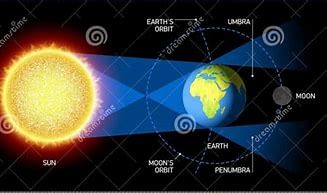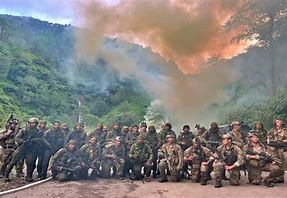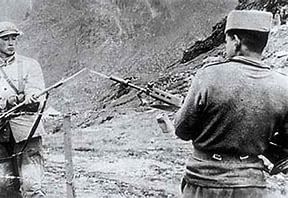UPSC Daily Current Affairs- 22nd November 2023 | Current Affairs & Hindu Analysis: Daily, Weekly & Monthly PDF Download
GS-I
Understanding Eclipses: Why they don’t happen every Month
Subject: Geography

Why in News?
While Eclipses are intriguing, one might wonder why eclipses do not occur with every new and full moon.
What are Eclipses?
- Eclipses are astronomical events that occur when the sun, moon, and Earth align in specific ways.
- There are two primary types of eclipses: solar and lunar.
- A solar eclipse happens when the moon comes between the sun and Earth during a new moon, blocking out the sun’s light.
- Conversely, a lunar eclipse occurs when the Earth is positioned between the sun and the moon during a full moon, casting a shadow on the moon.
Role of Lunar Nodes
- Lunar Nodes: The moon’s orbit intersects Earth’s orbital plane at specific points known as nodes, categorized as ascending or descending nodes depending on the moon’s orbital direction.
- Eclipse Occurrence: Eclipses happen when a full or new moon closely aligns with one of these nodes, ensuring the sun, moon, and Earth are in alignment.
Eclipse Pairs and Seasons
- Eclipse Pairs: Solar and lunar eclipses typically occur in pairs, with one following the other within a two-week period.
- Eclipse Seasons: Eclipse seasons, lasting around 34 to 35 days, usually feature two eclipses – one solar and one lunar. Occasionally, three eclipses may occur in a single season.
- Frequency: Contrary to common perception, there are more eclipses than expected, with the 21st century witnessing 224 solar eclipses and 230 lunar eclipses.
Understanding the Lunar Nodes and Eclipses
- Eclipse Seasons: Eclipse seasons take place approximately every 173 days when the lunar nodes precisely align with the Earth and the sun.
- Moon’s Progression: The moon’s phases shift about 30 degrees along the zodiac every month concerning the nodes.
- Future Eclipses: After a pair of eclipses, the next pair usually occurs nearly 6 calendar months later.
Source: Indian Express
What the OECD Report says of Climate Finance ahead of COP 28?
Subject: Geography
Why in News?
A recent report published by the OECD reveals that economically developed countries failed to fulfill their commitment to jointly mobilize $100 billion per year for climate mitigation and adaptation in developing countries in 2021, missing the 2020 deadline.
- The report’s findings have significant implications for the upcoming COP 28 climate talks in the United Arab Emirates, where climate finance is expected to be a contentious issue.
Key Findings of the OECD Report
- Shortfall in Climate Finance: Developed countries mobilized $89.6 billion in climate finance in 2021, falling short of the $100 billion target.
- Decline in Adaptation Finance: The report highlights a 14% decrease in financing for climate adaptation in 2021 compared to the previous year.
Significance of the OECD Report
- Representation of Developed Nations: The OECD consists of affluent countries such as the U.S., the U.K., Germany, France, Switzerland, and Canada, providing insights into their climate finance priorities before the COP 28 talks.
- COP 26 Pledge: The report follows a commitment by developed nations at COP 26 in 2020 to double adaptation finance and acknowledges their failure to meet the $100 billion goal on time.
Climate Finance Accountability and Issues
- Composition of Climate Finance: The report reveals that a significant portion of public climate financing comes in the form of loans, raising concerns about debt stress in developing countries.
- Loan Classification: The report’s treatment of loans without considering grant equivalents can exacerbate the burden on poorer nations, as loans may require repayment with interest.
- ‘Additionality’: The UNFCCC mandates that developed countries provide “new and additional” financial resources for climate purposes, preventing the diversion of funds from other essential sectors like healthcare.
- Lack of Defined Criteria: Developed countries have resisted efforts to establish a clear definition of climate finance, allowing ambiguity in classifying various types of funding.
- Double-Counting: Some developed countries have been accused of double-counting development aid as climate finance, leading to the misallocation of resources.
Climate Finance Needs and Future Projections
- The OECD report suggests that $100 billion was likely met in 2022, but this data remains preliminary and unverified.
- Developing countries are projected to require approximately $1 trillion annually for climate investments by 2025, escalating to $2.4 trillion per year from 2026 to 2030, highlighting the inadequacy of the $100 billion goal.
Role of the Private Sector
- High hopes for private sector involvement in climate finance have been tempered by the OECD report, which shows stagnant private financing for climate action.
- Climate adaptation faces particular challenges in attracting private investment due to lower potential returns compared to mitigation projects like renewable energy.
Conclusion
- The OECD report on climate finance underscores the gap between promises made by developed nations and their actual contributions.
- Issues of loan classification, additionality, and a lack of clear criteria for climate finance need to be addressed for greater transparency and accountability.
- As developing countries face growing climate-related challenges, public funding from governments and multilateral development banks remains crucial to meeting their needs.
Source: The Hindu
GS-II
Exercise ‘Vajra Prahar 2023’ Commences in Meghalaya
Subject: International Relations

Why in News?
Recently, the 14th edition of the Vajra Prahar 2023 exercise, a joint venture between India and the USA Special Forces, concluded in Bakloh, Himachal Pradesh. Here are the key highlights:
Exercise Vajra Prahar
- Vajra Prahar is an annual exercise alternately hosted by the Special Forces of India and the United States.
- These Special Forces units are dedicated to covert operations, counterterrorism, and other specialized military tasks.
- It is crucial for addressing the security challenges both nations face in the current global context.
- It has reinforced the friendship and defence cooperation between the Special Forces of India and the USA.
Objectives
- The 21-day joint exercise aimed to enhance skills in Airborne Operations, Special Operations, and Counter Terrorism under the United Nations Charter.
- It was divided into two stages:
- The initial stage focused on combat conditioning and tactical special mission training.
- The second stage involved a 48-hour validation exercise to assess the training received in the first phase.
Other Joint Exercises between India and the USA
- Yudh Abhyas: Annual army exercise focusing on enhancing military cooperation and understanding.
- Malabar Exercise: Naval exercise, also including Japan and Australia, focusing on complex maritime operations.
- Cope India: Air force exercise aimed at improving interoperability and mutual understanding between air forces.
- Tiger Triumph: Tri-service amphibious exercise focusing on humanitarian assistance and disaster relief.
- Red Flag: Advanced aerial combat training exercise involving the U.S. Air Force and international participants, including India.
- Spartan Shield: Army exercise aimed at building operational capacity in counter-insurgency and counter-terrorism.
Source: Indian Express
1962 India-China War
Subject: International Relations

Why in News?
On November 21, 1962, in a surprising move, China declared a ceasefire in a war against India, a conflict it seemed to be winning.
- This war was a critical event for both countries, impacting India’s Prime Minister Nehru and showcasing China’s military strength.
Origins of the 1962 India-China War
- India’s ‘Forward Policy’: India’s strategy of establishing outposts in contested areas is often seen as a trigger for the war. Critics suggest that these moves by an underprepared Indian Army might have forced China’s hand.
- Sheltering the Dalai Lama: India’s choice to offer refuge to the Dalai Lama, fleeing from Chinese rule in Tibet, was another significant factor. China saw this as a chance to assert its dominance in Asia.
- China’s Internal Struggles: Inside China, there was growing dissatisfaction with Mao Zedong’s Great Leap Forward, a policy aimed at rapid modernization. A successful war could help improve Mao’s standing.
Ceasefire and Withdrawal
- Stretched Chinese Supply Lines: China’s quick advance stretched its supply lines thin. With the Indian Army putting up a strong defense and the harsh winter setting in, the situation became more favorable for India. The difficult mountainous terrain also posed a challenge for China.
- International Involvement: Nehru’s call for help to the US and UK led to quick support. President Kennedy sent weapons and supplies to India, and the Royal Air Force joined in. This global response hinted at a possible escalation of the conflict, which China might have wanted to avoid.
- Changing Global Opinion: China’s capture of Tawang could have been a strategic stop, but its further advance into Indian Territory after October 24, 1962, shifted global opinion. Western powers started to view the situation more seriously, putting pressure on China.
Understanding China’s Strategy
- A Tactic for Negotiation: Chinese scholar Hong Yuan suggested that China’s involvement in the war was not for conquest but for negotiation. The PLA’s military actions, reaching as far as New Delhi, were meant to facilitate peace talks.
- Ensuring Long-Term Peace: The victory secured a peaceful border for China for the next fifty years. It showed that while war was a means to an end, it wasn’t the ultimate goal.
Conclusion
- The 1962 India-China war, marked by China’s ceasefire and strategic retreat, is a complex and layered part of Indian history.
- This ceasefire, though temporary, has a profound impact on the geopolitical landscape of the region and the world even today.
Source: The Hindu
GS-III
Risk weight
Subject: Economy

Why in News?
Recently, the Reserve Bank of India (RBI) has increased the cost of funds for banks and non-bank financial companies (NBFCs) by increasing the risk weight of such loans.
About Risk weight:
- It is every rupee lent by the bank is a cost or has an implication on its capital position.
- Risk-weighted assets: These are used to determine the minimum amount of capital a bank must hold in relation to the risk profile of its lending activities and other assets.
- The Reserve Bank of India decided in April 1992 to introduce a risk-asset ratio system for banks (including foreign banks) in India as a capital adequacy measure in line with the Capital Adequacy Norms prescribed by the Basel Committee.
- Impacts
- Lower the risk weight, lower the rate of interest. Therefore, risk weights impact borrowers indirectly and are felt through the pricing of loans.
- The increase in risk weights by the RBI will elevate funding costs for NBFCs and impact capital requirements.
Source: The Hindu
Atmospheric Waves Experiment (AWE)
Subject: Science and Technology

Why in News?
NASA is set to launch the Atmospheric Waves Experiment (AWE) to study ‘airglow’ to understand space weather.
About the Atmospheric Waves Experiment (AWE):
- It is a first-of-its-kind NASA experimental attempt aimed at studying the interactions between terrestrial and space weather.
- It is planned under NASA’s Heliophysics Explorers Programme. This mission will study the links between how waves in the lower layers of the atmosphere impact the upper atmosphere and, thus, space weather.
- It will be launched and mounted on the exterior of the Earth-orbiting International Space Station (ISS).
- From the vantage point, it will look down at the Earth and record the colourful light bands, commonly known as airglow.
- The new NASA mission will try to understand the combination of forces that drive the Space weather in the upper atmosphere.
- It will measure the airglow at mesopause (about 85 to 87 km above the Earth’s surface), where the atmospheric temperatures dip to minus 100 degrees Celsius.
- At this altitude, it is possible to capture the faint airglow in the infrared bandwidth, which appears to be the brightest, enabling easy detection.
- It will be able to resolve waves at finer horizontal scales than what satellites can usually see at those altitudes, which is part of what makes the mission unique.
- The health of the ionosphere, whose lower layers sit at the edge of space, is important for maintaining seamless communication.
What will NASA’s AWE do?
- It will perform focused mapping of the colourful airglows in the Earth’s atmosphere.
- Onboard AWE is an Advanced Mesospheric Temperature Mapper (ATMT), an instrument that will scan or map the mesopause (a region between the mesosphere and thermosphere).
- Using the four identical telescopes comprising an imaging radiometer, scientists hope to obtain the brightness of light at specific wavelengths.
- This information can then be converted into a temperature map, which could reveal the airglow movement and, ultimately, give clues on their role in the upper atmosphere and Space weather.
What is an airglow?
- It is a faint luminescence of Earth’s upper atmosphere that is caused by air molecules’ and atoms’ selective absorption of solar ultraviolet and X-radiation.
- Most of the airglow emanates from the region about 50 to 300 km above the surface of Earth, with the brightest area concentrated at altitudes around 97 km.
Source: Indian Express
Tantalum
Subject: Science and Technology

Why in News?
Recently, a team of researchers from the Indian Institute of Technology (IIT), Ropar, found the presence of tantalum, a rare metal, in the Sutlej river sand in Punjab.
About Tantalum:
- It is a rare metal with the atomic number 73—the number of protons found in one atom of the element.
- The rare metal has been named after a Greek mythological figure, Tantalus.
- Properties
- It’s grey, heavy, very hard, and one of the most corrosion-resistant metals in use today.
- It possesses high corrosion resistance because, when exposed to air, it forms an oxide layer that is extremely difficult to remove, even when it interacts with strong and hot acid environments.
- When pure, tantalum is ductile, meaning it can be stretched, pulled, or drawn into a thin wire or thread without breaking.
- It is almost completely immune to chemical attack at temperatures below 150°C and is attacked only by hydrofluoric acid, acidic solutions containing the fluoride ion, and free sulphur trioxide."
- It also has an extremely high melting point, exceeded only by tungsten and rhenium.
- When it is placed in the midst of acids, it is incapable of taking any of them up.
- Applications
- It is most prominently used in the electronic sector.
- The capacitors made from tantalum are capable of storing more electricity in smaller sizes without much leakage than any other type of capacitor.
- This makes them ideal for use in portable electronic devices such as smartphones, laptops, and digital cameras.
- As tantalum has a high melting point, it is frequently used as a substitute for platinum, which is more expensive.
- The rare metal is also used to make components for chemical plants, nuclear power plants, aeroplanes and missiles.
- It does not react with bodily fluids and is used to make surgical equipment and implants, like artificial joints
- A composite consisting of tantalum carbide (TaC) and graphite is one of the hardest materials known and is used on the cutting edges of high-speed machine tools.
Source: Indian Express
|
38 videos|5293 docs|1118 tests
|
















